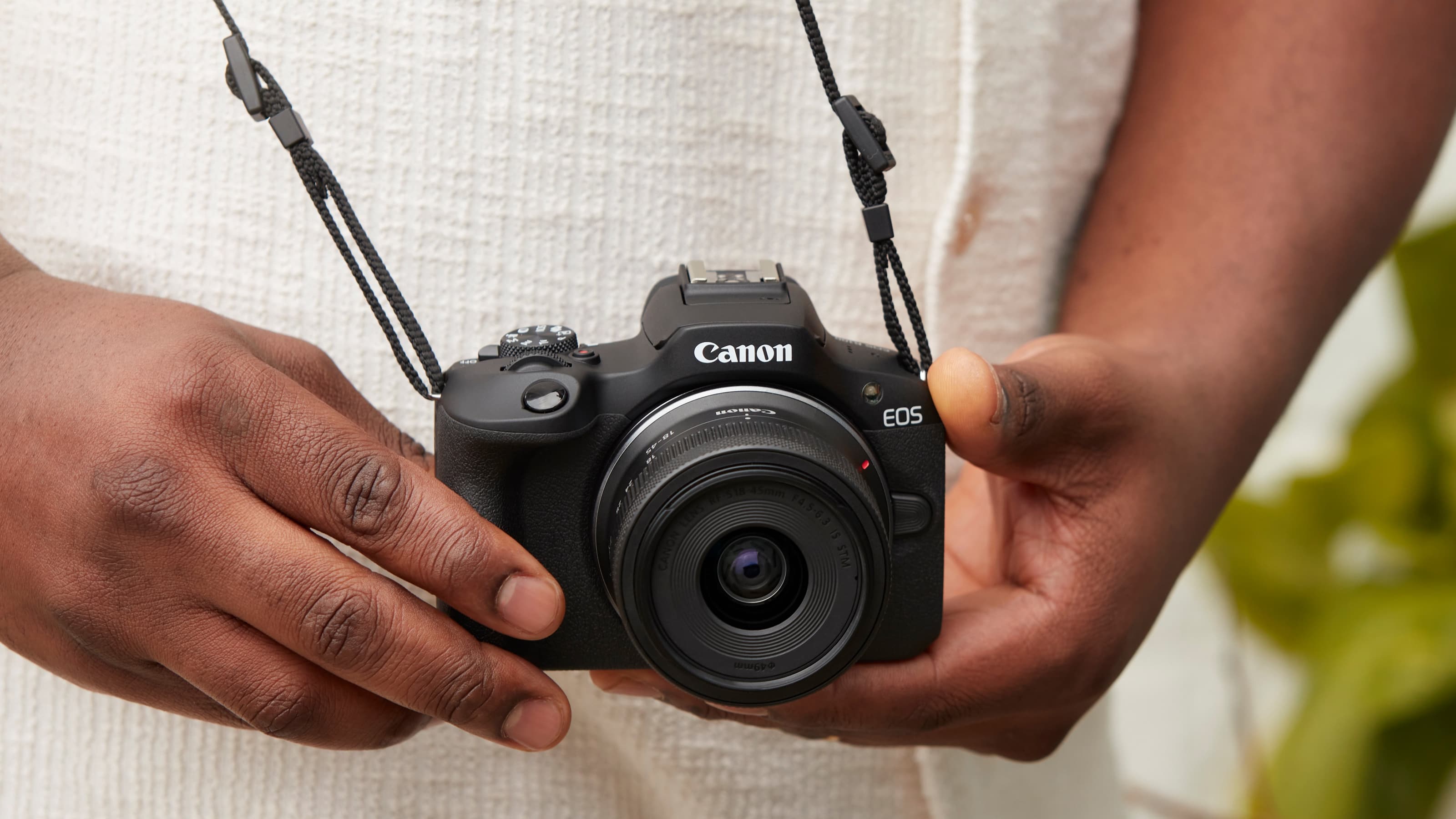Canon R100 vs R50: which Canon EOS RF-S mirrorless camera is best for you?
This Canon EOS R100 vs EOS R50 camera comparison is finely balanced around price versus value

When the Canon EOS R50 was announced we took it to be the entry-level beginner model in the growing Canon RF APS-C camera range. But then Canon announced a more basic model still, the EOS R100, which is priced very keenly indeed. We’ve complained for a while that no-one is making affordable beginner cameras any more, but with the EOS R100 Canon has put that right.
We’ve yet to test it properly, but it looks a shoe-in for our guide to the best beginner cameras, perhaps even the best mirrorless cameras.
If we had to characterize the cameras in this comparison, we’d say that the EOS R50 uses Canon’s latest mirrorless tech to produce an affordable all-round camera that’s not as advanced, obviously, as the EOS R10 and EOS R7, but still highly capable for both stills and video.
The EOS R100, however, uses older sensor and processing technology that we’ve seen before in the EOS Rebel SL3 / EOS 250D, and in the EOS M50. It still works fine, but has limitations for 4K video and, in this camera, there’s fixed rear display.
Canon has done this kind of thing before, with the EOS 1300D way back in the day and more recently the EOS Rebel T7 / EOS 2000D and the even cheaper EOS Rebel T100 / EOS 4000D, a camera so cheaply made that we wondered if Canon had simply set the bar too low. Canon has made some of the best DSLRs on the market, but these weren’t among them.
The Canon EOS R100 looks better than that. So how does it compare against the next model up in the range, the EOS R50?
Canon EOS R100 vs R50 in 2025
Why you can trust Digital Camera World
1. Sensor
• Canon EOS R100: 24.1MP APS-C, DIGIC 8, ISO 100-12800, exp 100-25600
• Canon EOS R50: 24.2MP APS-C, DIGIC X, ISO 100-32000, exp 100-51200
Both of these cameras have 24-megapixel APS-C sensors, but the sensors and the technology behind them are not the same. The EOS R100 uses an older-generation sensor with an older DIGIC 8 processor. It has a lower maximum ISO and, as we shall see shortly, has limitations for video capture. Nevertheless, if your main interest is stills photography and unless you intend shooting in very low light, you probably won’t see any difference in image quality between the EOS R100 and EOS R50.
2. Autofocus
• Canon EOS R100: Dual Pixel CMOS AF, 3975 points, Humans (Eyes/Face/Head/Body)
• Canon EOS R50: Dual Pixel CMOS AF II, 4503 points, Humans (Eyes/Face/Head/Body), Animals (Dogs, Cats and Birds) or Vehicles (Racing cars or Motor bikes)
Both cameras use Canon’s highly effective Dual Pixel CMOS AF systems but, as with the sensor tech, the differences lie in the details. The EOS R100 achieves its low price using an older sensor design and AF system, while the EOS R50 uses Canon’s more up to date Dual Pixel CMOS AF II system. This offers a few more AF points but hardly enough to matter. What is key, though, is that it’s available when shooting 4K video and has extended subject recognition and tracking features.
3. Continuous shooting
• Canon EOS R100: 6.5fps, 97 JPEG, 17-C-RAW
• Canon EOS R50: 15fps, 28 JPEG, 7 RAW
Neither camera is especially suited to burst shooting, even though the continuous shooting speeds look promising. The problem is the buffer capacity, which severely limits the length of time these cameras can keep shooting at full speed before slowing down. The EOS R100 doesn’t do too badly, offering 97 JPEGs but only at 6.5 frames per second. The EOS R50 can shoot twice as fast but only for a couple of seconds with JPEGs, and hardly any time at all if the camera is set to capture raw files.
4. Video
• Canon EOS R100: 4K UHD 25p, FHD 60p, HFR HD 120p
• Canon EOS R50: 4K UHD 30p, FHD 60p, HFR FHD 120p
On paper, both cameras shoot 4K UHD video and slow motion up to 120fps, but there are profound differences. The EOS R100 and its older sensor and processor bring serious 4K limitations. You can only capture 4K with a 1.55x crop, which is really bad news given the lack of native Canon RF-S wide-angle lenses, the maximum frame rate is 25p rather than the more usual 30p, and in 4K mode you’re restricted to much slower contrast AF. You only get Dual Pixel CMOS AF if you drop down to full HD resolution. And while both cameras offer a 120p slow-motion HFR mode, the EOS R50 can do this at full HD resolution, while the R100 is limited to 720 standard HD, which is rarely used now.
5. EVF and LCD
• Canon EOS R100: EVF, 0.39, 2.36m dots, 3-inch fixed, 1.04m dots
• Canon EOS R50: EVF, 0.39, 2.36m dots, 2.95-inch vari-angle, 1.62m dots
These two cameras use the same 0.39-inch, 2.36m dot EVF, which is perfectly acceptable in cameras at this price point and the EOS R100 is at no disadvantage here. However, when you move round the back, everything changes. The EOS R100 uses a fixed 3-inch screen without even a tilt mechanism, and without touchscreen functionality, which is almost unheard of in today’s cameras. The EOS R50, however, has a full vari-angle touchscreen – a major difference with an impact on all kinds of day-to-day shooting.
6. Storage
• Canon EOS R100: 1x SD UHS I
• Canon EOS R50: 1x SD UHS I
Both cameras have a single SD/SDHC/SDXC memory card slot that can take UHS I memory cards. This is not as fast as the higher UHS II standard, but a fast UHS I card will be perfectly capable of handling these cameras’ relatively basic video and burst shooting features.
7. Battery life
• Canon EOS R100: LP-E17, 430/340 shots
• Canon EOS R50: LP-E17, 440/310 shots
Again, there’s nothing to choose between these two cameras. Both use an LP-E17 rechargeable lithium ion battery found widely in Canon’s entry-level cameras, and while there is a technical difference in battery life on paper, the differences are so small that you’re never going to notice in everyday shooting. You may need to buy a spare, and we can help you find the best value option in our best camera battery guide.
8. Size and weight
• Canon EOS R100: 116.3 x 88.1 x 58.7mm, 356g
• Canon EOS R50: 116.3 x 85.5 x 68.8mm, 375g
Canon’s specs show the EOS R100 as being a little taller but less deep than the EOS R50, but they look identical to us so perhaps it’s a difference in the way they’ve been measured, e.g. with/without protuberances. The EOS R100 is a little lighter, though not by enough to make an obvious difference in the hand.
9. Price
• Canon EOS R100: $599 / £669
• Canon EOS R50: $799 / £899
We’re quoting the prices at launch, so these may change over time, but it’s pretty clear that Canon has judged the price difference very well, offsetting the EOS R100’s more basic specifications by a substantial difference in price of around $200 / £220. This means the EOS R100 offers a very significant saving for those who can do without the R50’s video features and vari-angle screen.
Canon EOS R100 vs EOS R50: conclusions
On the face of it, the EOS R100 is somewhat disappointing. It follows a familiar Canon route of packing relatively old technology in a new, basic but effective camera body. The cropped 4K video and its AF limitations are one drawback and the fixed rather than vari-angle screen another. But the EOS R100 still has a 24-megapixel sensor and a decent AF system which will probably be fine for first-time mirrorless camera users interested mostly in stills.
Yes, the EOS R50 is clearly a better, faster, more advanced camera, but it also costs significantly more. If you can stretch to the EOS R50 we’d say get it, but if money is tight then the EOS R100 still has a lot to offer while being a great deal cheaper to buy.
Best lenses for the Canon EOS R100
Best lenses for the Canon EOS R50
Best Canon cameras
Best beginner cameras
The best camera deals, reviews, product advice, and unmissable photography news, direct to your inbox!

Rod is an independent photography journalist and editor, and a long-standing Digital Camera World contributor, having previously worked as DCW's Group Reviews editor. Before that he has been technique editor on N-Photo, Head of Testing for the photography division and Camera Channel editor on TechRadar, as well as contributing to many other publications. He has been writing about photography technique, photo editing and digital cameras since they first appeared, and before that began his career writing about film photography. He has used and reviewed practically every interchangeable lens camera launched in the past 20 years, from entry-level DSLRs to medium format cameras, together with lenses, tripods, gimbals, light meters, camera bags and more. Rod has his own camera gear blog at fotovolo.com but also writes about photo-editing applications and techniques at lifeafterphotoshop.com





